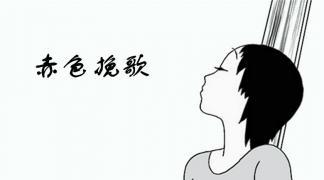Recommend a short but impressive animation work, "Red Elegy", which is the work of Japanese animator Shizuichi Hayashi in the 1970s. Although decades have passed, a group of Japanese animators in the middle and late 1900s of the last century have outlined the living conditions and background of the times in the Showa era with a unique perspective and skillful painting skills, and these works still have a certain appeal today. Born in 1945 in Tohoku, China, Mr. Hayashi joined Toei Animation at the age of 17 and participated in a series of anime and manga. He has won dozens of excellent comics and animation works over the decades, and has won many international awards.

"Red Elegy" is an edited adaptation of the author's autobiographical comic book work, and from the title, it is difficult to associate this seemingly grand name with the story itself. But the author's connotation contained in it can only be seen by careful taste, and there is always something unfinished after every time you look at it.
The story tells the story of two young men and women who meet and fall in love in the city and are forced to break up due to reality. The short film is only 20 minutes, there is no exaggerated dialogue, from beginning to end with paper-like scene switching, with realistic sound effects and catchy interludes, in the quiet and vicissitudes of the narration, the author shows a relationship in his youth to the audience, superb storyboarding and narrative skills can't help but be substituted into the storyline.
In the 1950s, Japan was unfamiliar and incomprehensible to the profession of animator, and countless animators worked hard in a difficult environment, insisting on their dreams with a meager income. Silhouettes of the city at dusk are repeatedly seen in the film, birds and planes flying slowly through the sky, and the slow pace contrasts with this impetuous city.
The heroine, Sachiko, runs away from home under the pressure of marriage and lives with ichiro, a manga artist who has no job. Like most young couples, the two who work hard in the city enjoy a simple and happy world of two people. However, this happiness is often hit by various accidents. After Sachiko informs her compromised family that she has a lover, she is overwhelmed by a kind of uneasy sorrow, and when she sees Ichiro who does not pay attention to him and is buried in painting, the burden in her heart eventually disappears quietly in Ichiro's confession.
The life of a cartoonist is monotonous and difficult. With no source of income, constantly receiving rejections, and the pressure of life made Ichiro say the words of parting in anger. The director does not use the usual character expressions to portray Sachiko's reaction, but appropriately conveys Sachiko's wandering and anger with the scene of smashing the pot and smashing the bowl and the thunderstorm. Despite the quarrel, the relationship between the two heats up until they receive the news of Ichiro's father's death, which makes a rootless couple fall into the storm again.
Under the pressure of moral responsibility, Ichiro is caught in a dilemma of choice. Whether to work or go home, a decision that makes Ichiro begin to think bitterly about their relationship and prepare for a breakup. Trivialities become unbearable rifts, and the two drift apart in the hurt of each other.
One of the few backgrounds in the short film is a silhouette of the city at dusk, adding a sense of loneliness to the lonely two. Ichiro proposes to break up again, and the background of the fan is bright red, implying ichiro's fiercely struggling inner world. At the same time, the director borrows the scene of Ichiro shooting his finger at the city's congestion on the overpass, expressing his disgust for the city and his yearning for freedom.
The portrayal of the character in the film is also often highlighted. After Ichiro proposed to break up, Sachiko threw Ichiro's manuscript all over the room, and the strong little girl did not cry, but said calmly, I thought you were the one who would not say break up!
In the excavation of human nature and the film expression method, the author also shows imaginative genius skills. The pain of separation on the one hand makes Ichiro full of contradictory expectations and endures the thought of Sachiko, and on the other hand, he has to refuse when they meet. Unable to escape the end of their breakup, Sachiko knocks ichiro down with a gun in her hand, cutting off the two's last ties.
The brilliance of the short film is also that although several points can be ended at any time, Ichiro's strong sense of loss has rippled in the audience's heart, but the director does not end with tragedy, and unexpectedly gives the audience a reasonable human performance. After returning to the hut in pain and vomiting excessively in grief, Ichiro still gritted his teeth and got up to clean the futon, telling himself and the audience that they would continue tomorrow, and yes, they thought the same thing yesterday.
There is no vigorous passion and struggle, this is just a fading love elegy, how many lovers in the city dream, taste happiness in hardship, and finally end the dream in reality. Wherever one goes, the road continues, as sung in that soft and poetic song:
Day by day sheng song A marquee hits the eye like a marquee
Falling cherry blossoms blow snow Annoy the emotions also move
Unsurfaced light bulbs illuminated our ball
What about talking about love?
No one can answer the truth of happiness...